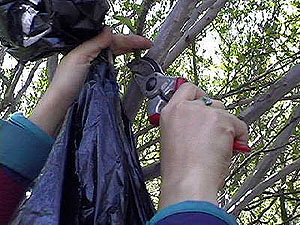|
Techniques for Collecting and Preparing Plant
Specimens
Materials needed:
Techniques
for collecting plant specimens:
In order to
make a positive species identification, a plant specimen should have both
flowers and fruits. However, sterile specimens may be useful for identification
to the level of genus, and in some cases even to species.
Steps to
follow in making a voucher specimen:
- Cut a portion of the plant (the size
of the specimen should not exceed that of the newspaper) which includes
flowers and/or fruits. Take enough material for at least two voucher
specimens.
- Give the specimen a number (collection
number) and note it on a notebook.
- Note the habit of the specimen (i.e.
tree, shrub, herb, etc.), and also its size.
- Note the color of the flowers and/or
fruits; and any other noteworthy characteristics (i.e. aroma, presence of
latex, etc.).
- Note the habitat of the specimen (i.e.
scrubland, arroyo, etc.)
- Tie up the stems of the specimens
using the masking tape and write the specimen number on the tape. Place in a
plastic bag.
- Press specimens between newspaper
(number the paper with the number on the masking tape so you can later
associate it with your notes).
- Dry plants in a plant dryer (one can
be found in the BIO labs building at UT, it can be accessed by contacting
the curator of the Plant Resources Center in the Main Tower)
- Once plants are dried, they can be
identified.
Return to
Methodological Documentation
|

